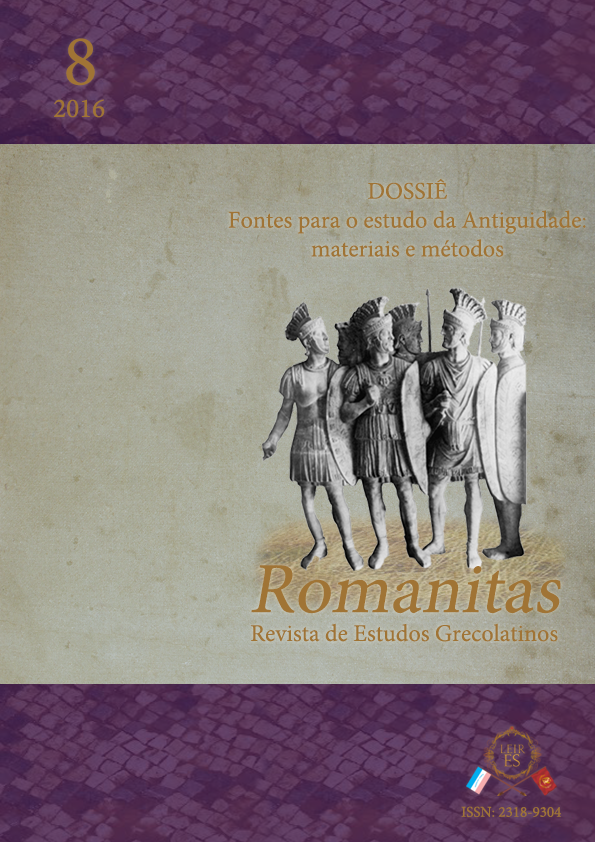Then 'Ogham Stones': sources for the study of ‘Hibernia’ and ‘Britannia romana’ (and post-Roman Britain)
DOI:
https://doi.org/10.17648/rom.v0i8.15164Keywords:
Sources, Antiquity, Ogham Stones, Hibernia, Britannia romana, Post-Roman BritainAbstract
Since the establishment of History as a Science (Geschichtswissenschaft), among the major transformations of historiographical field one can notice the expansion of the notion of document, no longer understood only as written texts but as any evidence of human presence. Like other areas, Ancient History also followed these changes, which led into a renewal of sources, materials and methods for the study of Antiquity. This article aims at presenting some notes about a documentary corpus little explored by Brazilian historiography, the Ogham Stones, important material evidence for the study of Hibernia and Britannia romana (and post-Roman Britain).
Downloads
References
ADAMS, J. N. Bilingualism and the Latin language. Cambridge: Cambridge University Press, 2004.
BRUUN, C.; EDMONDSON, J. The Oxford handbook of Roman epigraphy. Oxford: Oxford University Press, 2015.
CARNEY, J. Early Irish literature: the state of research. International congress of celtic studies, p. 128-130, 1983.
______. The invention of the Ogom cipher. Ériu, v. 26, p. 53-65, 1975.
CHARLES-EDWARD, T. M. Early Christian Ireland. Cambridge: Cambridge University Press, 2000.
CLARKE, R. R. An Ogham inscribed knife-handle from South-West Norfolk. The Antiquaries Journal, v. 32, p. 71-73, 1952.
CONNELLY, C. J. A partial reading of the Stones: a comparative analysis of Irish and Scottish Ogham pillar stones. Thesis – University of Wisconsin, Milwaukee, 2015.
DAVIES, W.; GRAHAM-CAMPBELL, J. CISP – Celtic Inscribed Stones Project, 1999. Disponível em: <http://www.ucl.ac.uk/archaeology/cisp/database/>. Acesso em: 30 jul. 2016.
DI MARTINO, V. Roman Ireland. London: The Collins Press, 2003
FORSYTH, K. S. The Ogham inscriptions of Scotland: an edited corpus. Thesis – Harvard University, Harvard, 1996.
FREEMAN, P. Ireland and the Classical World. Houston: University of Texas Press, 2001.
FULFORD, M.; HANDLEY, M.; CLARKE, A. An early date for Ogham: the Silchester Ogham stone rehabilitated. Medieval Archaeology, v. 44, p. 1-23, 2000.
HARVEY, A. The Ogham inscriptions and the Roman alphabet: two traditions or one? Archaeology Ireland, v. 4, n. 1, p. 13-14, 1990.
HINGLEY, R. Hadrian’s Wall: a life. Oxford: Oxford University Press. 2012.
MAC COITIR, N. The Ogham alphabet: a military origin? Archaeology Ireland, v. 26, n. 1, p. 22-25, 2012.
MACALISTER, R. A. S. Corpus Inscriptionum Insularum Celticarum. Dublin: Stationery Office, 1945/1996.
MAcMANUS, D. A guide to Ogam. Maynooth: An Sagart, 1991.
MONTGOMERY, G. The ancient origins of sign handshapes. Sign Language Studies, v. 2, n. 3, p. 322-334, 2002.
MOORE, F. The Ogham stones of County Kerry. In: MURRAY, G. Medieval treasures of County Kerry. Kerry: Walsh Colour Print, 2010, p. 6-18.
NASH-WILLIAMS, V. E. The early Christian monuments of Wales. Cardiff: University of Wales, 1950.
NÍ BHROLCHÁIN, M. An introduction to early Irish literature. Dublin: Four Courts Press, 2009.
Ó CRÓINÍN, D. Early medieval Ireland 400-1200. London: Longman, 1995.
OKASHA, E. Corpus of early Christian inscribed stones of South-West Britain. Leicester: Leicester University Press, 1993.
RAFTERY, B. Ireland: a world without the Romans. In: GREEN, M. J. The Celtic world. London: Routledge, 1996, p. 636-653.
ROCHE, J. The influence of Ireland on Roman Britain cursus unicus? Archaeology Ireland, v. 7, n. 1, p. 7-9, 1993.
ROWE, G. Epigraphical cultures of the Classical Mediterranean: Greek, Latin and beyond. In: ERSKINE, A. (Ed.). A companion to ancient history. Chilchester: Wiley-Blackwell, 2009, p. 23-36.
SANTOS, D. A cultura Hiberno-latina na Bretanha romana e pós-romana: evidências a partir das Ogham Stones. Anais eletrônicos do XXVIII Simpósio Nacional de História, 2015. Disponível em: <http://www.snh2015.anpuh.org/resources/anais/39/1434321851_ARQUIVO_Aculturahiberno-latinaversaofinal.pdf>. Acesso em: 10 jun. 2016.
______. How the historical Patrick was transformed into the St. Patrick of religious faith. New York: The Edwin Mellen Press, 2013.
SCHAPS, D. M. Handbook for classical research. New York: Routledge, 2011.
STEVENSON, J. The beginnings of literacy in Ireland. Archaeology, Celtic Studies, History, Linguistics, Literature, v. 89, p. 127-165, 1989.
THOMAS, A. C. And shall these mute stones speak? Post-Roman inscriptions in Western Britain. Cardiff: University of Wales Press, 1994.
______. Irish colonists in South-West Britain. World Archaeology, v. 5, n. 1, p. 5-13, 1973.
THURNEYSEN, R. A. A grammar of old Irish. Dublin: DIAS, 2003.
VANDERBILT, S. Roman inscriptions of Britain (RIB). Disponível em: <http://romaninscriptionsofbritain.org/>. Acesso em: 30 jul. 2016.
WHITE, N. Ogham in 3d project, 2012. Disponível em: . Acesso em: 30 jun. 2016.
WOOLF, G. Literacy or literacies in Rome? In: JOHNSON, W. A.; PARKER, H. N. (Ed.). Ancient literacies: the culture of reading in Greece and Rome. New York: Oxford University Press, 2009, p. 46-68.
Downloads
Published
How to Cite
Issue
Section
License
Copyright (c) 2017 Romanitas - Revista de Estudos Grecolatinos

This work is licensed under a Creative Commons Attribution-NonCommercial-NoDerivatives 4.0 International License.
a. The authors retain copyright and grant the journal the right to first publication.
b. The authors are authorized to assume additional contracts separately, for non-exclusive distribution of the version of the work published in this journal (e.g., publishing in institutional repository or as a book chapter), with acknowledgment of authorship and initial publication in this journal.
c. Authors are allowed and encouraged to publish and distribute their work online (e.g. in institutional repositories or on their personal page) after the first publication by the journal, with due credit.
d. The journal's texts are licensed under a CC BY 4.0 Deed Attribution 4.0 International Licence (CC BY).




























